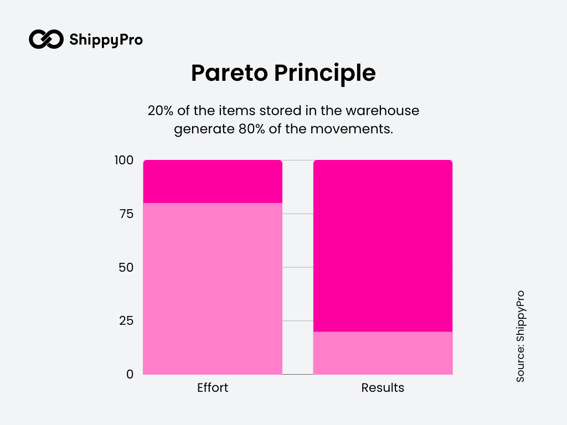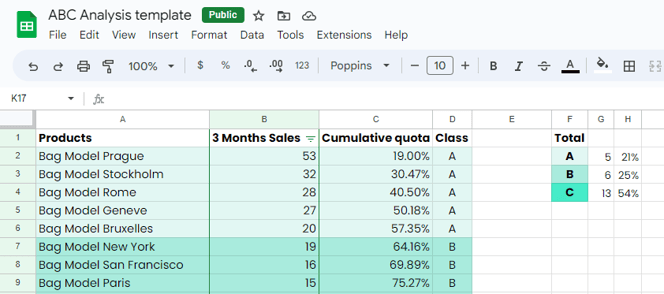ABC analysis in inventory management: how to do it [+ template]

ABC analysis, along with warehouse automation, is a useful tool for optimising inventory levels and reducing management costs. Moreover, it provides benefits to several strategic departments of a company. Let's find out about its advantages and how it works.
What is ABC analysis?
Based on the Pareto principle, or 80/20 rule, according to which 80% of the results depend on 20% of the efforts or causes, ABC analysis applies this concept to the warehouse. In fact, according to this principle we can state that 20% of the items stored in the warehouse generate 80% of the movements, while the remaining 80% of the products are responsible for only 20% of the movement of the goods and therefore of the revenue. ABC analysis allows you to identify which items to focus on and which ones to focus on less, classifying all the goods into three classes to optimise costs and the operational phases of picking and warehouse management… but not only - as we will see later!
ABC analysis allows you to identify which items to focus on and which ones to focus on less, classifying all the goods into three classes to optimise costs and the operational phases of picking and warehouse management… but not only - as we will see later!
Classes in ABC inventory management
In ABC analysis, inventory items are classified into three categories, namely A, B, and C, based on their importance to the business. These categories are determined by the percentage of total annual usage value, which is calculated using the formula:
(Annual number of items sold) x (Cost per item) = Annual usage value per product
Let’s discover the various classes in ABC analysis more in detail.
Class A: high value items
These are the most valuable items in the inventory and typically represent the top 20% of items that account for 80% of the total revenue. This means these are high-value items that require frequent monitoring and reordering to avoid stock-outs because they are strategically important for the company.
Class B: medium value items
These are the items of medium importance and represent 30% of inventory items. Despite the slightly slower turnover, these are items that need to be followed closely, since they can easily fluctuate between Class A and C.
Class C: low value items
Class C items are the most numerous and account for 50% of the items in the warehouse but are the least requested by customers. These are low-value items that require little management and can be ordered in large quantities to reduce order frequency.
ABC analysis is particularly beneficial for the ecommerce and retail sector especially in terms of customer segmentation. Retailers can use ABC analysis data to understand which are their most requested products and, as a result, prioritise their marketing efforts accordingly. This may involve more solid promotions and advertising of those products, leading to increased sales.
In general, ABC analysis can provide useful insights to many departments within a business, from logistics and inventory management to purchasing, production or the commercial department.
Pros and cons of ABC analysis
ABC analysis is a valuable tool for businesses who need to optimise their inventory management and allocate resources strategically. However, like everything, it has its pros and cons. Let’s find out about them.
Advantages of ABC analysis
More efficient cycle counts
ABC analysis helps businesses to allocate resources efficiently during cycle counts, in other words the process of counting portions of inventory at different times. The purpose of conducting cycle counts is to make sure that inventory is up to date, thus allowing merchants to make informed decisions. Cycle counts are conducted depending on inventory size and the specific needs of a business. Instead of counting all inventory items during each cycle, with ABC analysis businesses can prioritise items based on their importance and calculate only the necessary items required for each class of inventory.
Better control of high priority inventory
Thanks to ABC analysis merchants can give priority to Class A inventory, namely products that are more popular among customers. Since this inventory Class is directly connected to the success of the company, it is essential to constantly monitor it, making sure that stock levels correspond to its demand. In this way, Class A inventory is prioritised over inventory that is less important and less critical to all operations.
Improved efficiency and reduced inventory costs
ABC analysis helps businesses to manage inventory effectively, minimising the risk of stock-outs and reducing inventory holding expenses. It allows to reduce excess inventory, especially when it comes to low-value items. In this way, there will always be the right resources available to meet demand and no extra items uselessly increasing warehousing costs.
Improved demand planning
ABC analysis collects valuable data related to products with high demand. Thanks to this information businesses can strategically set stock levels and prices to increase their sales.
Improved customer satisfaction
When you think about IKEA you immediately picture the iconic BILLY bookcase. This famous product, launched in 1979 is still incredibly popular today with one BILLY bookcase being sold every 5 seconds somewhere in the world. Well, imagine going to IKEA with the intention of buying a BILLY bookcase, only to find out it is out of stock. Frustrating, isn’t it? Undoubtedly!
This kind of frustration can be felt by your customers as well, and this is why it is so critical to focus on inventory items based on their value and importance.
Customers need to know they can always find the product they are looking for. For retailers, on the other hand, it is essential to prioritise their “BILLY” to increase customer loyalty. By working in this way, businesses will also avoid complaints and long waiting times.
Disadvantages of ABC analysis
System differences
ABC analysis may conflict with traditional costing methods and in fact is not compliant with the GAAP (generally accepted accounting principles). Because of this incompatibility, stock managed using the ABC analysis method normally requires another costing system to comply with GAAP.
Category association challenges
In ABC analysis it may be challenging to determine the appropriate category to assign to each item, especially because media trends and seasonality could cause unpredictable demand patterns. In order to manage sudden rises in demand, it is useful to monitor and update classification regularly, taking seasonal fluctuations into account and predicting possible market changes ahead of time.
More time-consuming
Unlike traditional costing systems, ABC analysis requires more resources. In fact, Class A items necessitate constant maintenance as they are crucial to a business’ success. In general, it is a system that needs constant updates and data collection that could result in higher costs.
How to calculate it + ABC analysis Excel template
 To perform a thorough ABC analysis, begin with ordering all the items in your warehouse or ecommerce, measured in units sold, in descending order, based on the sales volumes of a specific period of time (for example 3 months), on a normal spreadsheet.
To perform a thorough ABC analysis, begin with ordering all the items in your warehouse or ecommerce, measured in units sold, in descending order, based on the sales volumes of a specific period of time (for example 3 months), on a normal spreadsheet.
The metrics involved in our calculation are:
- The three classes (A, B, C)
- Each unit sold is equal to "1"
- The sales volumes of items in your warehouse or ecommerce in a specific period
The items that belong to class A will be fewer than those belonging to class C.
When you open the link, click on Make a copy to create a local copy of the template. The ABC analysis template can be downloaded on your PC and opened in Excel. Go to File > Download > Microsoft Excel.
ABC analysis tools
There are various tools that businesses can use to perform ABC analysis in inventory management. Here are some of the most common ones:
Spreadsheet software
Microsoft Excel or Google Sheets are commonly used for ABC analysis and can effectively organise and sort inventory data, calculate value of items, and classify them.
Technology
If you don’t want to manually count inventory and keep track of it on an Excel sheet, there are fortunately many inventory management software that include the ABC analysis functionality and real time visibility of all items in stock. These help to reduce the time it takes to manually perform calculations and automate the process of analysing data from inventory records.
Ultimately, the right tool for ABC analysis depends on a company’s specific needs. Spreadsheet software is a common and affordable option, whereas more advanced tools require higher investment.
ABC analysis example
Here is an example of how ABC analysis can be applied in the manufacturing industry:
A device manufacturer may categorise their high-value components, like mobile phones or cameras, as class A items, which are of high value but make up a smaller percentage of inventory.
Class B items are all those components such as screens, motherboards or lenses that are not quite as valuable but account for a moderate portion of the total inventory value - and volume - and should thus be managed accordingly.
Class C items are low-value items, like earphones or cases, but account for the vast majority of inventory.
The manufacturer can prioritise Class A items, making sure they are always available. Also, he can use the data collected with ABC analysis to negotiate better terms with suppliers, exploring efficient ways to reduce waste and cost for lower value items.
Overall, ABC analysis can be applied to many different industries and can help businesses to optimise their resources, reduce costs, and generate more profits.
Passionate freelance copywriter, with a niche in ecommerce and logistics. When collaborating with ShippyPro, she loves writing about trends, marketing and communication strategies to help brands gain an edge in an ever-evolving digital landscape.











